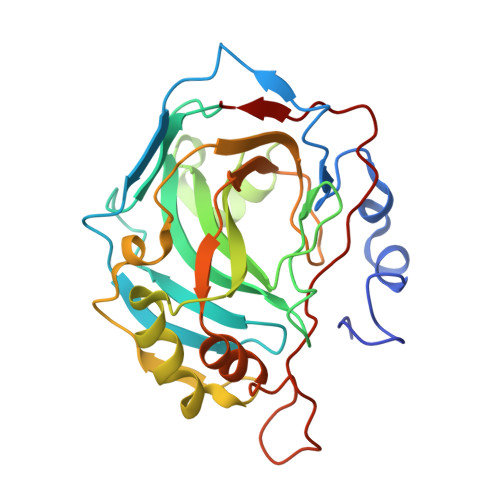Carbonic anhydrase inhibitors. Interaction of the antitumor sulfamate EMD 486019 with twelve mammalian carbonic anhydrase isoforms: Kinetic and X-ray crystallographic studies
Temperini, C., Innocenti, A., Scozzafava, A., Supuran, C.T.(2008) Bioorg Med Chem Lett 18: 4282-4286
- PubMed: 18640037
- DOI: https://doi.org/10.1016/j.bmcl.2008.06.105
- Primary Citation of Related Structures:
3DD8 - PubMed Abstract:
The new antitumor sulfamate EMD 486019 was investigated for its interaction with twelve catalytically active mammalian carbonic anhydrase (CA, EC 4.2.1.1) isozymes, hCA I - XIV. Similarly to 667-Coumate, a structurally related compound in phase II clinical trials as steroid sulfatase/CA inhibitor with potent antitumor properties, EMD 486019 acts as a strong inhibitor of isozymes CA II, VB, VII, IX, XII, and XIV (K(I)s in the range of 13-19nM) being less effective against other isozymes (K(I)s in the range of 66-3600nM against hCA I, IV, VA, VI, and mCA XIII, respectively). The complete inhibition profile of 667-Coumate against these mammalian CAs is also reported here for the first time. Comparing the X-ray crystal structures of the two adducts of CA II with EMD 486019 and 667-Coumate, distinct orientations of the bound sulfamates within the enzyme cavity were observed, which account for their distinct inhibition profiles. CA II/IX potent inhibitors belonging to the sulfamate class are thus valuable clinical candidates with potential for development as antitumor agents with a multifactorial mechanism of action.
Organizational Affiliation:
Università degli Studi di Firenze, Polo Scientifico, Laboratorio di Chimica Bioinorganica, Rm. 188, Via della Lastruccia 3, 50019 Sesto Fiorentino, Florence, Italy.

















